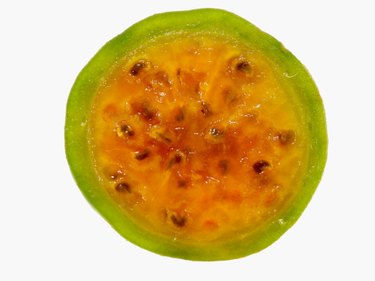
The pineapple guava, classified under the scientific name Feijoa sellowiana, produces fragrant sweet fruit. The plant grows 3 to 20 feet tall in a multi-stem shrub form. Plant pineapple guava outdoors in USDA plant hardiness zones 8 and 9. When the sweet fruit ripens, collect some of the seeds to start new plants, or propagate pineapple guava from rooted cuttings.
Seed Propagation vs. Cloning
Video of the Day
The two methods used to propagate pineapple guavas are; from seed and, by rooted cuttings. Pineapple guava seeds germinate quickly and reliably making this the primary method of propagation. Like many fruit trees, pineapple guavas do not reproduce true to seed but they produce close enough to the parent plant that growers favor seed propagation. Rooted cuttings and cloning produce an identical plant to the parent plant. Both methods are suitable and reliable ways to propagate a pineapple guava.
Video of the Day
Collecting Pineapple Guava Seeds
Pick fully ripe pineapple guavas. Pineapple guavas are ripe when the fruit separates easily from the plant. Cut open the fruit and squeeze or scoop the flesh and seeds into a bowl. Add enough water to cover the fruit pulp and the seeds. Purdue University recommends leaving the seeds to ferment in the bowl of water for four days at room temperature. Once the seeds and fruit separate, place the seeds in a colander and rinsing them thoroughly. Set the clean, rinsed seeds out to dry on a paper towel for a few hours and then store in a cool dry place until planting.
Germinating Pineapple Guava Seeds
Prepare a seed-flat with soil-less seed-starting mix. Pineapple guava seeds are prone to soil microbes that exist in garden soil and soil-based potting soil. A soil-less seed starting mix provides a sterile environment, increasing germination rates. Use a mix of equal parts sand, perlite and peat moss or coconut coir to provide an environment that combines good drainage, a loose medium and a support system for the new seedlings. Pineapple guava seeds take 21 to 30 days to germinate at 70 degrees F, according to University of Oklahoma Department of Biology and Microbiology.
Cloning Pineapple Guava
Propagate pineapple guava from rooted cuttings. Take 4- to 6-inch cuttings in summer. The best cuttings come from the tips of branches produced during the seasons growing period. The wood should be springy and green. Avoid hardwood cuttings when propagating pineapple guava. Root the cuttings in damp sand and keep them in a greenhouse or indoor area. Placing the pots on a heat source increases rooting success. Home and garden centers sell heating pads designed for horticulture use. Dip the end of the cuttings in a hormone rooting compound to further increase rooting success rates. Pineapple guava cuttings take 10 days to root, according to Purdue University.
- University of Oklahoma Department of Biology and Microbiology: Pineapple Guava
- Purdue University; Feijoa; Julia F. Morton
- University of University of Connecticut Ecology and Evolutionary Biology Plant Growth Facilities: Feijoa
- United States National Arboretum: U.S. Department of Agriculture Plant Hardiness Zone Map